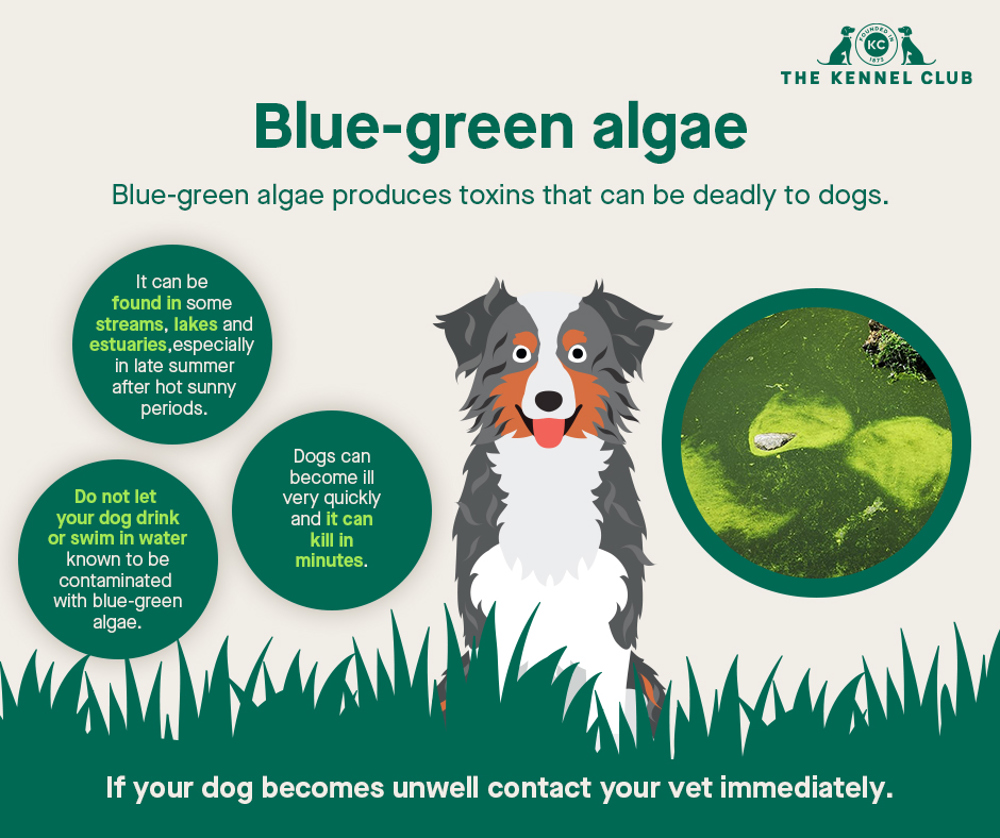
Blue-green algae is a toxic substances that’s found in lakes and rivers around the UK. It can be very dangerous to dogs and can even be deadly. Find out more about where you would find it and the effects it can cause in our article below.
A summary of blue-green algae
- Blue-green algae can be found in some streams, lakes, rivers, estuaries and the sea, especially in late summer after hot sunny periods
- Blue-green algae can produce toxins that may be deadly to dogs
- Do not let your dog drink, or swim in, water that you think might be contaminated with blue-green algae
- If your dog becomes unwell, contact your vet immediately
What is blue-green algae?
Despite the name, blue-green algae actually describes several types of bacteria that live in water. They are found throughout the UK in some ponds, streams, lakes, rivers and thrive in warm and nutrient rich water. Certain types of blue-green algae produce toxins that can be poisonous to wildlife, humans and dogs. Under certain conditions blue-green algae can multiply rapidly, forming large “blooms” that can contaminate and pollute the water, making it dangerous to animals.
Is blue-green algae toxic to dogs?
Many blue-green algae contain, or make, a number of different toxins. These toxins are often harmful to dogs, and can even be deadly. Dogs are most commonly exposed when swimming, playing in, or drinking from contaminated water. Dogs may lick the contaminated water from their fur and can be poisoned this way.
If you come across a body of water that you think may contain blue-green algae, do not go in it yourself, or let your dog swim in it or drink from it.
What does blue-green algae look like?
Water that contains blue-green algae may appear a different colour, often looking like pea soup. Blooms are not always large and can sometime be seen in smaller areas of the water close to the shore. The algae may be blue-green in colour, or can even be red, brown or black. The water may sometimes smell musty, earthy or grassy, and you may sometimes see foam along the shoreline.
What time of year is blue-green algae most common?
The amount of blue-green algae found in a waterbody may change throughout the year. It’s found most often in, or after, hot and sunny periods (i.e. mid to late summer) and especially after heat waves.
What are the signs of blue-green algae poisoning?
The types of toxins produced by blue-green algae may vary, and so can their effects. These effects can range from dribbling, tiredness, vomiting and diarrhoea (both of which may be bloody) to effects on the heart and blood pressure, convulsions, problems breathing or organ failure. Signs often start within an hour, but may occur within a few minutes, or can sometimes be delayed by a few days. Many cases are life threatening and dogs can die very quickly.
What should I do if I think my dog has been poisoned by blue-green algae?
- You should take your dog to the vet urgently
- Seeking treatment quickly is vital in helping improve their chances of survival. Blue-green algae often needs rapid treatment, so it is important that your dog sees a vet straight away
- If possible, get someone to call ahead to the vet to let them know you are on your way. This will give them time to prepare for when your dog arrives
- If you’re not near your home, you can find a vet near you on the Royal College of Veterinary Surgeon’s website
What should I do if I think a waterbody is contaminated by blue-green algae?
If you come across a body of water that you think may contain blue-green algae, do not go in it yourself, or let your dog swim in it or drink from it.
In the UK, incidents of blue-green algae should be reported to the Environment Agency which has a 24-hour incident hotline (telephone: 0800 80 70 60).
Think your dog may be affected?
If you're worried about your dog's health, always contact your vet immediately!
We're not a veterinary organisation and so we can't give veterinary advice, but if you're worried about any of the issues raised in this article, please contact your local vet practice for further information.
